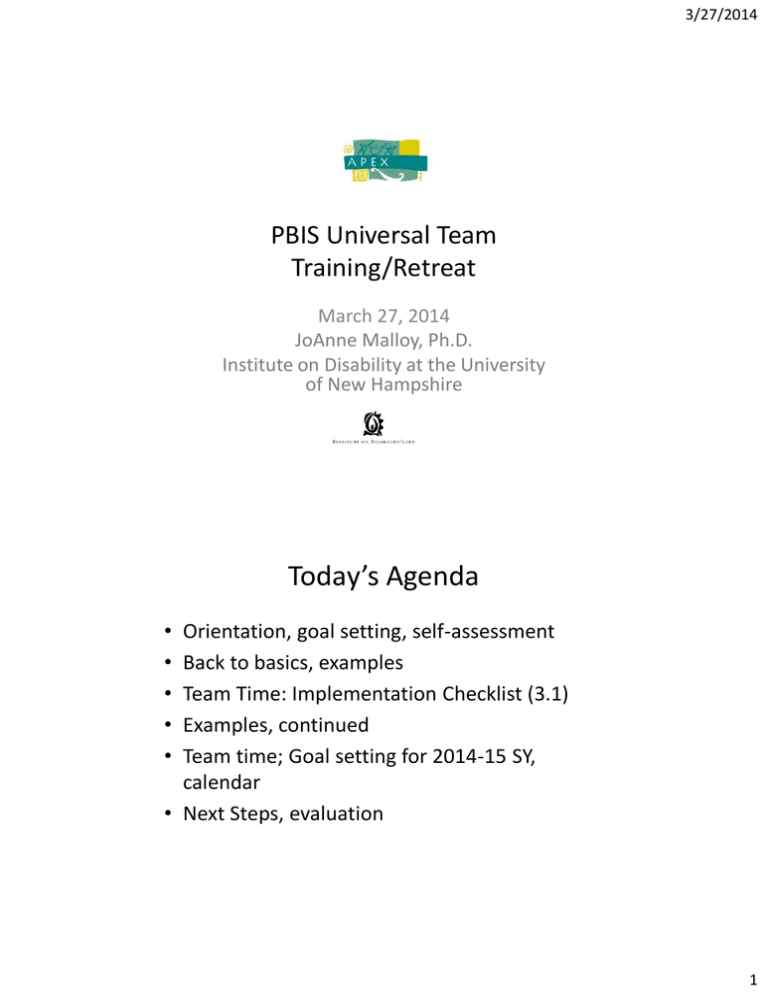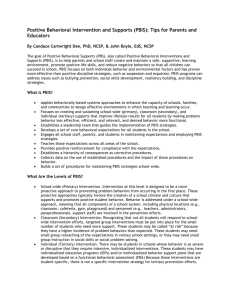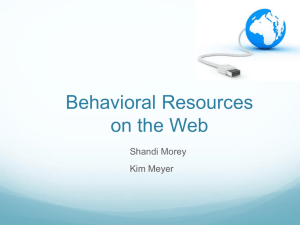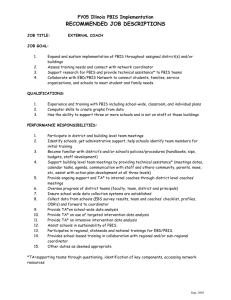Today’s Agenda PBIS Universal Team Training/Retreat
advertisement

3/27/2014
PBIS Universal Team
Training/Retreat
March 27, 2014
JoAnne Malloy, Ph.D.
Institute on Disability at the University
of New Hampshire
Today’s Agenda
•
•
•
•
•
Orientation, goal setting, self-assessment
Back to basics, examples
Team Time: Implementation Checklist (3.1)
Examples, continued
Team time; Goal setting for 2014-15 SY,
calendar
• Next Steps, evaluation
1
3/27/2014
Expectations
Be Responsible
Be Respectful
Be Prepared
Make sure you are comfortable & that your personal needs are
met
Address question/activity in group time before discussing “other”
topics
Address your attention to the topic and task
Ask questions
Turn cell phones, beepers, PDA’s, and pagers off or to
vibrate/silent
Contribute to activities and conversations where possible
Bring your learning hat, and leave other hats behind
Follow through on assigned tasks
Acknowledgements
• CEBIS at SERESC, SLC, IOD: New Hampshire PBIS
Network
• George Sugai, Rob Horner: OSEP Technical
Assistance Center on Positive Behavioral
Interventions and Supports (www.pbis.org)
• Steve Goodman & Beth Steenwyck
– Michigan Implementation Network:
www.min.cenmi.org
– Michigan’s Integrated Behavior and Learning Support
Initiative (MiBLSi): Miblsi.cenmi.org
2
3/27/2014
“In theory there is no difference
between theory and practice;
in practice, there is.”
Yogi Berra
IMPLEMENTATION SCIENCE
Theory
Implementation
Practice:
Better
Outcomes
3
3/27/2014
Stages of Implementation
Moving Science to Service
Fixsen & Blasé, 2005
Exploration/
Adoption
Installation
Initial Implementation
Full Implementation
Innovation
Sustainability
• Should we do this?
• Put resources and systems in place
• Initial pilots and assess results
• The practice was successful,
adopt system- wide
• Adopt variations of the practice
and assess results
• Make this the way of doing
business
Rate Your Level of Implementation
4
3/27/2014
In a given classroom of
25 students….
1 in 10 will
experience
a mental
health
problem of
severe
impairment
1 in 5 will
experience
a mental
health
problem of
mild
impairment
Less than half of those who need it will get services
Why do This?
• Increasingly diverse student population
–
–
–
–
Language, SES,
Academic ability (range)
Social behaviors
Stressors at home / community
• To meet the range of needs, teachers need to:
– Employ a range of instructional strategies
– Teach classroom routines to support higher level
thinking skills
– Encourage student behaviors
– Pointed toward self-management
5
3/27/2014
Reactive responses are
predictable….
When we experience aversive situation, we
want select interventions that produce
immediate relief
–
–
–
–
Remove student
Remove ourselves
Modify physical environment
Assign responsibility for change to student &/or
others
When behavior doesn’t improve,
we “Get Tougher!”
•
•
•
•
•
Zero tolerance policies
Increased surveillance
Increased suspension & expulsion
In-service training by expert
Alternative programming
…..Predictable systems response!
6
3/27/2014
Erroneous assumption that
student…
• Is inherently “bad”
• Will learn more appropriate
behavior through increased use of
“aversives”
• Will be better tomorrow…….
But….false sense of safety/security!
•
•
•
•
•
Fosters environments of control
Triggers & reinforces antisocial behavior
Shifts accountability away from school
Devalues child-adult relationship
Weakens relationship between academic &
social behavior programming
7
3/27/2014
Science of behavior has taught us
that students….
• Are NOT born with “bad behaviors”
• Do NOT learn when presented contingent
aversive consequences
……..Do learn better ways of
behaving by being taught directly
& receiving positive feedback
EAT YOUR PEAS!
New behaviors are taught and learned when:
There is a positive relationship between students
and staff/teachers
• The expectation is clearly and concisely described
• The behavior is explicitly taught (modeled)
• There is a reinforcement for the desired behavior
(and specific feedback)
•
8
3/27/2014
Teach & Practice……..
Prevent, Teach, Acknowledge
Think about how you teach content….
• Prevention: What environmental factors are
making the behavior better or worse?
• Teach: What can you do to make sure the
students know what you want them to do?
• Acknowledge: “4 positives to every 1
negative” (you give out grades….)
9
3/27/2014
• We can’t “make” students learn or behave
• We can create environments to increase
the likelihood students learn and behave
• Environments that increase the likelihood
are guided by a core curriculum and
implemented with consistency and fidelity
Does Everyone Know What is Expected
of Them?
10
3/27/2014
SW-PBS Logic!
Successful individual student
behavior support is linked to host
environments or school climates
that are effective, efficient, relevant,
& durable for all students
(Zins & Ponti, 1990)
Designing School-Wide Systems for Student
Success
Academic Systems
Behavioral Systems
Intensive, Individual Interventions
•Individual Students
•Assessment-based
•High Intensity
1-5%
Targeted Group Interventions
•Some students (at-risk)
•High efficiency
•Rapid response
Universal Interventions
•All students
•Preventive, proactive
5-10%
80-90%
1-5%
Intensive, Individual Interventions
•Individual Students
•Assessment-based
•Intense, durable procedures
5-10%
Targeted Group Interventions
•Some students (at-risk)
•High efficiency
•Rapid response
80-90%
Universal Interventions
•All settings, all students
•Preventive, proactive
11
3/27/2014
Effective Social & Academic
School Culture
Common
Language
RtI/
SWPBS
Common
Experience
Common
Vision/Values
SWPBS is
Framework for enhancing
adoption & implementation of
Continuum of evidence-based
interventions to achieve
Academically & behaviorally
important outcomes for
All students
12
3/27/2014
Outstanding Features of PBIS
•3-Tiered model provides a conceptual
framework and a scaffold for a whole-school
approach to behavior management
•Uses archival school records and disciplinary
referrals that allow estimation of a school’s
status and efficiency
•Applies the concept of continuous positive
support to student behavior
•Addresses all school settings
What are the Factors that
Make It Work?
• Consistent with the Priorities, Routines,
Values and Operations of the School Context
• Is an Example of a Good PracticeEnvironment Fit
• PBIS Considers the School as a Dynamic
System within a District and Community
Context.
13
3/27/2014
Factors (continued)
• PBIS Integrates-Coordinates Key Components
that are Evidence-Based and Acceptable to
Educators
• Strong focus on Implementation Fidelity that
is Measured Regularly and Prompts Actions
• Allows Flexible Adaptation and Fine Tuning of
PBIS Components
SCHOOL-WIDE
CLASSROOM
1.1. Leadership team
1.All school-wide
2.Behavior purpose statement
3.Set of positive expectations & behaviors
4.Procedures for teaching SW & classroom-wide
expected behavior
5.Continuum of procedures for encouraging
expected behavior
EVIDENCEBASED
INTERVENTION
PRACTICES
6.Continuum of procedures for discouraging rule
violations
INDIVIDUAL STUDENT
2.Function-based behavior support planning
3.Team- & data-based decision making
4.Comprehensive person-centered planning &
wraparound processes
5.Targeted social skills & self-management
instruction
6. Individualized instructional & curricular
accommodations
3.Positively stated expectations posted, taught,
reviewed, prompted, & supervised.
4.Maximum engagement through high rates of
opportunities to respond, delivery of evidencebased instructional curriculum & practices
5.Continuum of strategies to acknowledge displays
of appropriate behavior.
6.Continuum of strategies for responding to
inappropriate behavior.
7.Procedures for on-going data-based monitoring &
evaluation
1.Behavioral competence at school & district levels
2.Maximum structure & predictability in routines &
environment
NONCLASSROOM
1.Positive expectations & routines
taught & encouraged
FAMILY ENGAGEMENT
1.Continuum of positive behavior support for all
families
2.Frequent, regular positive contacts,
2.Active supervision by all staff (Scan, communications, & acknowledgements
move, interact)
3.Formal & active participation & involvement as
3.Precorrections & reminders
equal partner
4.Positive reinforcement
4.Access to system of integrated school &
community resources
14
3/27/2014
School-wide
1.
2.
3.
4.
Leadership team
Behavior purpose statement
Set of positive expectations & behaviors
Procedures for teaching SW & classroom-wide expected
behavior
5. Continuum of procedures for encouraging expected
behavior
6. Continuum of procedures for discouraging rule violations
7. Procedures for on-going data-based monitoring &
evaluation
Creating Environments to Increase the
Likelihood: Universals
• Annually:
– Revisit your set of expectations and teaching
activities
– Assess and address “problem spots” across school
environments
– Assess effective instruction and management in
each classroom
• High Rates of Positive Feedback
15
3/27/2014
Few positive SW expectations defined,
taught, & encouraged
Reviewing Strive for Five
• Be respectful.
• Be safe.
• Work peacefully.
• Strive for excellence.
• Follow directions.
McCormick Elem. MD 2003
16
3/27/2014
17
3/27/2014
EXCELLENCE
DISCIPLINE
INTEGRITY
RESPECT
PERSEVERANCE
In the Classroom
In the Hallway
In the Bathroom/
Locker room
In the Cafeteria
Arrival to and Departure from school
Keep Trying
Seek help when needed
Finish what you start
Maintain a positive
attitude
• Prepare yourself for
class quickly
Use appropriate language
and voice level
Respond positively to
reasonable requests
Be considerate of others’
learning
Use appropriate
language and voice
level
Keep hands and feet
to yourself
Make room for others
to pass
Do your own work
Support others’ learning
styles
Report problems to an
adult
Help others in need
Give others privacy
• Pay for and
Report problems to an Report problems to an consume your own
adult
adult
food and drink
•Support and include
one another
•Report problems to
an adult
• Always walk
•Support and include one another
•Leave the street at the door
•Report problems to an adult
Be on time
Be on task
Be prepared
Be organized
Walk
Keep to the right
Go directly to your
destination
Keep locker closed
Consistently follow
routines
Honor personal
space
Walk
•Follow the arrival and dismissal
procedure
• Enter and exit the building through the
designated door
Sit in your seat when on the bus
• Do your best work
•Listen to learn and
understand
•Keep classroom neat
•Engage in your learning
• Keep walls, lockers,
and floors clean
•Leave your area
clean
• Leave your area clean
•Follow all bus rules
Use appropriate
language and voice
level
Clean up after yourself
Flush!
Place personal items
in the proper
receptacle
Keep walls & stalls
clean
Consistently follow
routines
Return to room
promptly
• Be patient as you
wait your turn in line
Be patient as you wait
Stay in assigned area
Seek help when needed
Remove headphones from your ears
before entering the building
Use appropriate
language and voice
level
Clean up after
yourself
Be silent for
announcements
Keep hands, feet,
and food to yourself
Use appropriate language and voice
level
Respond positively to reasonable
requests
Keep hands and feet to yourself
Remove hats and silence phones when
entering the building
Identify Positive SW Expectations
1. Linked to social culture of school (e.g., community, mascot).
2. Considerate of social skills and rules that already exists.
3. 3-5 in number
4. 1-3 words per expectation
5. Positively stated
6. Supportive of academic achievement
7. Comprehensive in scope (school-wide – ALL students, staff, and settings)
8. Mutually exclusive (minimal overlap)
9. Contextually/culturally appropriate (e.g., age, level, language)
10. Agreement by >80% faculty and staff
11. Communicated to stakeholders (e.g., families, community members,
district administrators)
12. Included in school publications (e.g., handbook, posters, newsletters)
18
3/27/2014
Acknowledging SW Expectations:
Rationale
• To learn, humans require regular &
frequent feedback on their actions
• Humans experience frequent feedback
from others, self, & environment
– Planned/unplanned
– Desirable/undesirable
• W/o formal feedback to encourage desired
behavior, other forms of feedback shape
undesired behaviors
Are “Rewards” Dangerous?
“…our research team has conducted a series of
reviews and analysis of (the reward) literature;
our conclusion is that there is no inherent
negative property of reward. Our analyses
indicate that the argument against the use of
rewards is an overgeneralization based on a
narrow set of circumstances.”
– Cameron, 2002
• Cameron & Pierce, 1994, 2002
• Cameron, Banko & Pierce, 2001
19
3/27/2014
Reinforcement Wisdom!
• “Knowing” or saying “know” does NOT mean
“will do”
• Students “do more” when “doing
works”…appropriate & inappropriate!
• Natural consequences are varied,
unpredictable, undependable,…not always
preventive
Example Roll Out on Disrespect-February
2008
•
•
1. Identify the targeted behavior
– Be Respectful in the Classroom
2. Identified growth/performance goal
•
3. Share with the classroom why the behavior buy-in is important
– Reduce respect referrals by 25%
“We need to recognize that everybody, including you, has worth and brings value to the
classroom.” Nick Guadagnoli
•
•
4. Identify and teach learning strategy (Different Skits in all blocks)
– Universal team with the teachers
– Teachers with their students
5. Implement Recognition and Reward Program
– Praise
– Caught you doing something right card (Entered into a raffle)
– Respectful student of the week (treated to lunch with the principal)
20
3/27/2014
Did it make a difference?
Major Disrespect ODR's 07-08
100
90
RESPECT Roll out
80
64
70
60
56
60
52
50
40
32
23
30
22 22 24
20
3.3 4.3 3.3 3.5 2.6 1.3
10
2.3
1.4 1.6
1
0
Sept. Oct. Nov Dec. Jan. Feb. Mar. Apr. May Jun
91
Disrepect
ODRs
Av. Disrespect
ODR's per day
per month
41
Review: Positive Cultures Happen
When…
• Students move through our school and they
find:
– the rules are the same,
– the cues are the same and
– the consequences are the same
We have all felt the repercussions of this not
being the practice in our schools
21
3/27/2014
22
3/27/2014
Punishment
Punishment stops a behavior
But… punishment by itself has some major
side effects
Increases escape/avoidance
Encourages “sneaky” behaviors
Generates desire for revenge
Makes behavior harder to change
Does not teach
You can’t find a big enough hammer
It works both ways
It makes us filter (e.g., He’s always mean to me!)
45
Cycle of Negative Interactions and Exclusion
*Adapted from Augsburger, 1992
Beliefs:
Negative
Context
Results for
Youth:
Failure
Exclusion
Negative Adult Response:
Punishment
Assuming Control
Withdrawing Support
Ignoring
Adult or PeerInitiated Action:
Requesting
Criticizing
Demanding
Harassment
Threatening
Negative Youth
Response:
Arguing
Ignoring
Avoiding
Minimizing
Lying
23
3/27/2014
Linkages Between Learning, Brain
Development and Emotional and
Behavioral Skills
Maltreated Children and Emotional and
Behavioral Disorders
• Reactive Attachment Disorder — approximately
7% (Reams, 1999; Zeanah et al., 2004)
• Post Traumatic Stress Disorder (Reams, 1999) or
the PTSD symptom of hypervigilance (Frankel,
Boetsch, & Harmon, 2000; Pollak, Vardi, Bechner,
& Curtin, 2000; Pollak et al., 2005)-approximately
7%
• Adjustment Disorders — 40% (Reams, 1999)
• Regulatory Disorders — 22% (Reams, 1999)
24
3/27/2014
Science of Early Brain and Child
Development
Shonkoff, 2002
• Cognitive, emotional and social capacities are
inextricably intertwined and learning, behavioral
and physical and mental health are interrelated
over the life course
• Toxic stress in early years can damage developing
brain architecture and lead to learning and
behavioral problems and susceptibility to
physical and mental illnesses
• Brain plasticity and the ability to change behavior
decrease over time
Stress interferes with learning
Attention
Stress makes it hard to concentrate
Organization and other executive functions
Memory
Under stress students and adults will work harder
but produce poorer quality work
Daniel Coleman
25
3/27/2014
Developmental Trauma Disorder
(van der Kolk, 2005)
“many problems of traumatized children can be
understood as efforts to minimize objective threat
and to regulate their emotional distress” (p.403)
• These are survival responses to disordered or
dangerous environments
“{the child’s} maladaptive behaviors tend to inspire
revulsion and rejection…and is likely to lead to
labeling and stigmatizing children for behaviors that
are meant to ensure survival.” (p. 404)
Children/Youth Who Have Experienced
Trauma Need a Structured Environment
• Structuring is proactive, positive action
– To prevent problems.
– Insure success.
• Traumatized children need:
–
–
–
–
A Trusted Adult to Protect Them
A Safe Environment
A Predictable Environment
A Patterned Environment
• New development occurs only when the child
feels safe and secure.
• Consistency=Predictability=Security (Landreth, 2002)
26
3/27/2014
Logic for Teaching Positive Social
Emotional Skills
Big Ideas of PBIS
1.
2.
3.
4.
5.
6.
7.
8.
ALL students are part of ONE proactive educational system.
Employ evidence based curriculum, instruction, and interventions
matched to student needs.
Organize those practices into a multi-tiered continuum of
supports.
Professional development (onsite and offsite) and follow-up
modeling and coaching are provided to faculty/staff to ensure
effective instruction at all levels.
Work in teams representing all key stakeholders using a shared
decision-making process.
Create, articulate, and implement a framework with 3-5
positively-stated behavior expectations.
Consider culture (be trauma-informed).
Data are used to guide decisions and to build the system.
27
3/27/2014
Group Activity
• “Vote” on the Big Ideas
ORGANIZING YOUR SERVICES/RESOURCES
What do we already do? For whom? Is it effective?…
28
3/27/2014
VOC Rehab
Job’s for America’s
Graduates (JAGS)
JROTC
Manchester School of
Technology (MST)
Outreach coordinator
VLACS
Academic Level
system
Go Manchester
MCC
Citiyear
Upward Bound
Developed 2010-2011: in collaboration with
the RENEW Oversight Team, the Behavior
Support Team, the Administration Team and
with the help of West faculty and staff.
29
3/27/2014
Implementation of Effective Practices with and without an Implementation Support
Team
Percent of
Implementation
Time
Implementation
Team
No Implementation
Team
80%
14%
3 Years
17 years
Balas & Boren, 2000; Fixsen, Blase, Timbers, & Wolf, 2001
•
•
•
•
•
•
Composition of the Universal School
Leadership Team
Administrators
Curriculum/Assessment Director
General Education Classroom Teacher
Special Education Teacher
Behavior Specialist/Guidance/Psychologist
Reading/Literacy Specialist and/or Title I
Coordinator
• Family Member
• Paraeducator
30
3/27/2014
Identify Team Member Roles
•
Team Leader - starts the meeting, reviews the purpose of the meeting,
facilitates the meeting by keeping the team focused on each step
•
Recorder - taking notes, transcribing the team’s responses on flip chart paper,
transparency, etc
•
Timekeeper- monitors the amount of time available keeps the team aware of
time limits by giving “warnings” (i.e., “10 minutes left”)
Data Specialist- is trained in entering and accessing data from the SWIS data
system
•
•
Content Specialist- competent with behavioralprinciples and assists in analyzing
data
•
Administrator- actively encourages team efforts, provides planning time,
feedback, and support initiatives
•
Communications – acts as the point person for communication between the
team and staff regarding PBIS and behavior issues
•
PBIS Coach- district-level (external) or school-based (internal) individual that
facilitates the team through the process, becomes the school’s main contact
Tasks of the Universal School
Leadership Team
1.
2.
3.
4.
5.
Lead the Universal System
Meet regularly
Identify key issues/concerns
Conduct a site analysis
Identify data management system (SWIS,
Performance Pathways, district system)
6. Develop/revise the school-wide PBIS
program using current data
31
3/27/2014
Tasks of the Universal School
Leadership Team
7. Actively communicate with staff
members and families regarding the
activities of the school team
8. Develop lesson Plans and ensure the
understanding, implementation and
maintenance of the school-wide PBIS
program
9. Serve as exemplars for staff and families
Team Installation
1. Collaborative-wide Team
2. School Leadership Teams
1. Clusters, grade levels
2. Curriculum, instruction, etc.
32
3/27/2014
Prepare for Working Smarter
(Not Harder)
• Identify the multiple committees within our
school
• Identify purposes, outcomes, target groups, and
staff
• Identify how school-wide PBIS can be integrated
into existing committees and initiatives
Sample Committee/Group Review Matrix
Relation to
School Mission
& School
Improvement
Plan (1 = low, 5
= high)
Priority
(1 = low,
5 = high)
Attendance
Committee
1 2 3 4 5
1 2 3 4 5
Character
Education
1 2 3 4 5
1 2 3 4 5
1 2 3 4 5
1 2 3 4 5
School Spirit
Committee
1 2 3 4 5
1 2 3 4 5
Discipline
Committee
1 2 3 4 5
1 2 3 4 5
1 2 3 4 5
1 2 3 4 5
1 2 3 4 5
1 2 3 4 5
Committee/
Work Group
Purpose
Expected
Outcome
Target
Group
Membership
Safety Committee
DARE Committee
EBS Work Group
33
3/27/2014
Resource Mapping
District/Community
Organization, project,
Purpose
program, or initiative
Service
delivery
location
Target population
served/number
served
Before/After
School programs;
To reach out to all
Boys and Girls Club
Vacation and
youth to become
Youth in Manchester
Teen Center
summer;
productive youth
Programs and
camps
Students who have
High School
dropped out, College
courses, College
Prep High School
Prep courses
Students (175 stdnts)
Activities/services
Partnering
agencies
Arts, character
leadership, education
Manchester
and career development
School of
health and life skills
Technology
sports, fitness and
recreation.
Expected
outcomes
To earn credits
for classes and
prepare for
college; To gain
meaningful
Adult Ed program
for students who
have dropped out
Makin it Happen
To improve drop
out and enhance
positive youth
develop.
All students. The
majority of students are Training/Curriculum
helped in school
Manchester
Community
Resource Center
Computer classes,
career training, ESL, Lake Avenue
Financial
Wide Variety of Age
Case Management,
Employment and
In Schools
Career Guidance/ at
Risk and Drop out
Students will be
Instruction, job
able to be
Needy at Risk students coaching, skills training,
employed in a
NH Doe District
about 140 served in NH resume writing and
skilled job area
guidance
and/or go on to
college
My Turn
Contact
Build skills and
community
involvement.
Center for Adult
Learning
Vacation and summer
Training in academics
and careers
Data: what is
available?
Health dept.
Salvation Army
Kelly Hobbs- 622-1305;
www.makinithappen.org
NH Works, Voc To Help with
Rehab, WIA
employment
Contact Info: 647-8967
Contact Info: 624-6363
YEAR 1 OBJECTIVES (Use the TIC to guide
your plan)
• Establish leadership team
• Establish staff buy-in
• Build working knowledge & foundations of SW-PBS
practices & systems
• Develop Behavior Expectations and Matrix by
location
• Design and put into place a data collection system.
• Develop list of problem behaviors (major and
minors) and rules for responding (student
correction, re-teaching, time-out, etc.)
• Determine when expectations will be taught and
plan for implementation.
• Determine staff development needs and plan.
34
3/27/2014
MISSION STATEMENT
The purpose of the our PBIS Team is:
Example: “to guide, support, and sustain the
development of structures and systems that foster a
positive school climate and promote student learning”
AGENDA Item:
This will be done by: engaging families,
supporting staff.
This will be done by guiding and supporting over time the
necessary structures…
Mission Statement: Brainstorm Key
Words
35
3/27/2014
Mission Statement
•
•
•
•
Our team will be responsible for:
We will have oversight of:
We are concerned about:
We will do our work by:
PBIS Leadership Team Meeting Notes
Team Name:________________________________________________
Date:______________________
Moderator/Facilitator:________________________________________
Note Taker:_________________________________________________
AGENDA ITEMS:
Item/ ISSUE
DECISION MADE
ACTION ITEMS
WHO
WHEN
•
36
3/27/2014
Suggested Timeline for 2014
NEXT STEPS
• Next Team Meeting
• Subgroups:
– Committee Audit/Inventory
– Communication
37
3/27/2014
Team Implementation Checklist (TIC)
38




